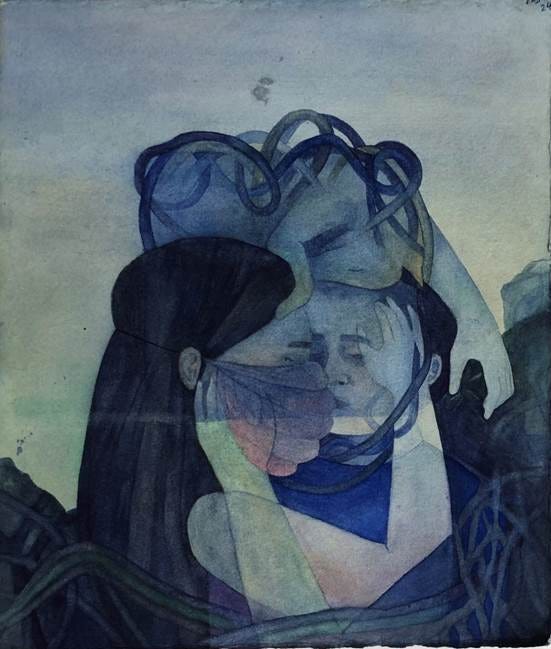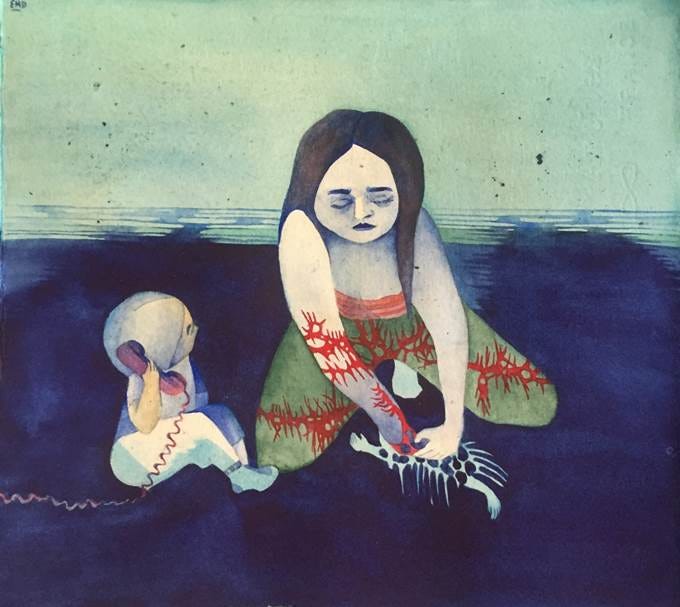The healing power of art
I sat down with Ella MacQueen-Denz, an artist based in Vancouver, Canada, who is currently in training to become an art therapist.
Ella MacQueen-Denz is an artist based in Vancouver, Canada, who is currently in training to become an art therapist. As we mark the centenary of Surrealist art, the 28-year-old discusses her artistic process and how creativity can lead to healing in vulnerable communities.
I've always drawn and painted since I could hold a utensil. That's always been my number one, and I spent a lot of time with my mom in her studio. She was a full-time artist until I was a teenager, and then she started her career in her 50s outside of her studio. So, I've always spent so much time with her painting, and she taught me a lot. She's a formally trained painter, but I am actually not. I just sort of learned by watching. I spent a lot of hours drawing figures as a child, so I think that came pretty naturally.
I love Leonora Carrington and I love Frida Kahlo. I grew up looking at my mom's art books, so I'm very influenced by Thomas Gainsborough, Claude Lorrain and medieval art. I'm definitely influenced by my mom’s style too, but I think also a part of developing my visual language is just sort of noticing what symbols and motifs come out, and not avoiding them, just welcoming them, not trying to force anything else.
It's hard to sell your work. It's really hard. It's not for the faint of heart. I actually resisted becoming an artist for a long time, because there was discouragement in my family. I always wanted to be an artist when I was a little kid, but when I became a teenager, I thought it didn’t seem practical. Then, in my early 20s, I realised that's actually the only thing I want to spend my time doing. So, I had to do it.
I grew up on a small Gulf Island, with a population of about 10,000 people. There are some islands that are a lot smaller than that. It has three ferry terminals, and that's the only way to get off the island. So, it was definitely more isolated and rural – not compared to other places in Canada, but definitely on the edge, and a small but tight community. I met a lot of artists through my mom, so I was exposed to the art community in that way. I'm grateful for that, but it's definitely a small and sheltered place. So that it was great to leave, go to the city and see all the possibilities.
I like painting things on a big scale, but I was moving around a lot in my early 20s, so it was great to just have something that's transportable. I love travelling. I love the feeling of leaving places and coming to new places. I think it's really interesting and inspiring. Back then, I was more prone to feeling stuck. I think I was wanting to move away from my family, but I really missed them. So, I always come back. It was honestly mostly due to practicality that I've started painting with watercolour. But I really love it. I'm sort of obsessed with it now.
The figures in my work might even be different parts of myself, so that's probably why they're more feminine. Something that stuck with me and became a big theme was leaving childhood, grappling with our lives as adults, and the grief of that. Not just grief, but I think I was sad when I was that age. I think that it was fear, fear of what was to come, leaving what I knew to be safe. Then also the shame, the shame of sexuality or being a sexual being, and the shame of not being a kid anymore. I don't know if I felt like it was necessarily a safe or good thing to be an adult or a teenager.
I'm also really interested and inspired by fairytales, and I think that's why. Fairytales do look into childhood a lot of the time, and what we're faced with in childhood or when leaving it. It can be kind of a microcosm for our entire existences, no matter what age we are.
I really believe that everybody is creative. Art is very healing and it can really open people up and move them through feelings. It’s a great form of therapy and somatic practice. For three years, I volunteered at an art group at Our Place shelter. It was a drop in so anybody could come, and it was sort of a chaotic space, because it's for the street community, so there's lots going on. There are huge problems in Victoria and Vancouver with drug addiction and substance use and people not getting safe housing and support from the government. It's very sad and problematic.
It was sort of like a little place of safety and calm for everybody. I did it with my friend who I met there, Shae Seqaqkind, and we now share a studio. She was very inspiring, and a great mentor for me. I really noticed how impactful and powerful doing art is, and also doing art together, doing it in a space where other people are doing it too. It definitely pushed me in the direction of art therapy.
I remember one person that would come to the table. His brother came, and they hadn't seen each other in a really long time. I think we were painting a mural together, and he ended up staying and watching the mural painting for four hours. And he was really glad that his brother was there, and I could tell it was a nice connection point for them. Sometimes you can't really tell if people are having a good time or not, as not everybody really says it. But I saw that it meant a lot for him to come here.
My most recent exhibition was in downtown Vancouver, so there was lots of visibility. I didn't frame the paintings because they were in the window, and it was nice to let the sides of the paper shine, because their sides are all tattered. It was a really positive reception.
I find that the three adjectives people usually use to describe my paintings are beautiful, creepy and cute. It's interesting. For every person that makes art, somebody will attribute a word to it. And you may be like, that’s cool, but I don't know if it really informs the way I think about it. I'm just doing it, and then people can interpret it the way they want to interpret it.
Sometimes there are insecurities in art. You have to really be ready to embrace your visual language and your style and not be afraid of it. I think there's a risk of being afraid of it and not going for it, but I have to just see it and welcome it. These are the people and things I paint, whether I like it or not. Some days I'm like, not another weird baby thing. I just have to let it come.
As told to Madison James.







